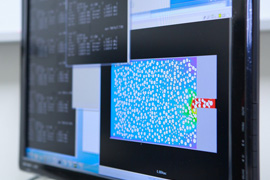- Student life
- Three fields of study
- Student's Graduation Thesis Theme
-
Student Blog
“Every day with Sha-an” - Award History
- Interview with Students
- Interview with Graduates
- Introduction of the Campus
- Campus Festivals
3. Societal Safety Science from the Perspective of Nature
Working on research into the natural environment of my interest
Research Theme
Examination of grout injection condition for CFD-DEM
Yusuke Yasuki of the Tomofumi Koyama research group
(Graduated from Takigawa Daini High School)

Reasons for my interest in this subject
Ever since I was a child, I have loved nature such as forests and oceans, so at university I wanted to study "safety" related to the natural environment.
This time, I did research on grout injection. Grout is a dense liquid that is injected into cracks in rocks to reinforce foundations. Grout injection is also used to improve water permeability. Normally, when grout is injected, cement and water are mixed and pressurized so as to flow, and various methods have been proposed for efficient injection. However, there is no clear prescription for its formulation and pressure. Its injection mechanism hasn’t been well studied yet. I learned that grout injection is done by experienced craftsmen on-site. I decided to do research on more efficient grout injection methods for a more robust foundation (in this research, I researched on a pressurized injection method with dynamic injection).
*What is grout?
Dense liquid to be injected to fill cavities, voids, gaps, etc., in construction work.
Research Flow

I read about 15 papers on foundation and grout and learned about the social background such as current situations where grout is used. Since it is an undeveloped field in which specialized research has not progressed yet, I had a hard time finding material. Professor Koyama kindly let me read valuable papers in his research room.

The grout dynamic injection method is an injection method performed by applying pressure while vibrating cement and water. Not only the differences in the cement and water mixing rates, but also certain fluctuation widths and the pressure of vibration can make injection into the cracks of rocks difficult. It’s not an optimum ground reinforcement. To find the optimum conditions, I made a system that can give a simulation on a PC while changing the vibration and pressure ratios little by little. It took half a year. Because there were no students working on the same research, I managed to complete it with a series of trials and errors.

I performed the simulation using two PCs. In one simulation, I simultaneously ran 5 patterns at once, and collected the data every day. It takes 8 hours to get a result, so you can only get up to 10 patterns per day. This was repeated every day for about a month. I was able to obtain data that seem to be close to the optimum numerical value, but I have not yet gotten convincing results and the research is still on going.

Grout injection is a construction method used in construction work, and my goal is to have my research results be used in construction work. Therefore, I also would like to obtain optimum data on materials and construction costs.
Regarding the formulation of cement and water for grout, more water makes for easier injection, but less cement requires more time to solidify and makes it weaker when it comes to water resistance. My goal is to find the optimal balance between the water and cement ratio, vibration and pressure, and the time and material costs required for injection.
Our next step! In August 2015, I would like to present my research achievements at an overseas academic conference in the civil engineering field. Until then, I would like to work on my research to obtain satisfying data. Because the conference will be held in English, I also want to focus on developing my English ability.
Checking other fields as well
- 1
Society - Constructing a framework for experts and citizens to study disaster prevention together
- Deepening knowledge about "insurance" necessary for daily life